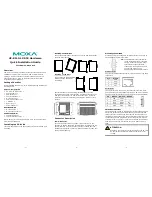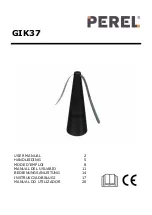
Panasonic Corporation Electromechanical Control Business Division
industrial.panasonic.com/ac/e/
PhotoMOS
®
Cautions for Use
Panasonic Corporation 2022
ASCTB65E 202201
Current limit function (output current control)
1) Current limit function aims to increase resistance to surges when
the switch is turned on. Before using this function, connect the
varistor to the output as shown in the figure below.
1
2
4
3
* Set the varistor voltage to 150 V or less.
Varistor
Surge: 10×160
μ
s 1.6kV
2) The current limit function capability can be lost if used longer than
the specified time. Be sure to set the output loss to the Max. rate.
Short circuit protection circuit
The short circuit protection circuit is designed to protect circuits from
excess current. Therefore, surge current may be detected as current
overload in which case the output current will be cut and the off
state maintained. For this reason, please include the inrush current
in the load current and keep it below the maximum load current.
Also, in order to maintain stability of internal IC operation, maintain
an input current of at least 5 mA (Latch type), 10 mA (Non Latch
type).
Photovoltaic MOSFET driver cautions for use
When two external MOSFETs are connected with a common source
terminal, oscillation may occur when operation is restored.
Therefore, please insert a 100 to 1,000 Ω resistor between the gate
terminal of the first MOSFET and the gate terminal of the second
MOSFET.
A typical example of this is given in the circuit below.
1
2
3
4
6
Input LED current
(For High Capacity type: with part number G)
When making PhotoMOS turn on and turn off, please make sure
that the LED forward current increases and decreases instantly.
Input voltage (for Power voltage-sensitive type)
For rising and dropping ratio of input voltage (dv/dt), maintain Min.
100 mV/s.
1) Power photoMOS
®
(1 Form A)
Absolute maximum rating
Recommended
load voltage
Load voltage
Load current
DC
type
AQZ
102
60
V DC
4
.
0
A DC
5,
12
,
24
V DC
AQZ105
100
V DC
2
.
6
A DC
48
V DC
AQZ
107
200
V DC
1
.
3
A DC
100
V DC
AQZ
104
400
V DC
0
.
7
A DC
200
V DC
AC/
DC
type
AQZ
202
Peak AC, DC
60
V Peak AC, DC
3
.
0
A
12
V AC
5,
12
,
24
V DC
AQZ205 Peak AC, DC
100
V Peak AC, DC
2
.
0
A
24
V AC
48
V DC
AQZ
207
Peak AC, DC
200
V Peak AC, DC
1
.
0
A
48
V AC
100
V DC
AQZ
204
Peak AC, DC
400
V Peak AC, DC
0
.5 A
120
V AC
200
V DC
2) Power photoMOS
®
(1 Form B)
Absolute maximum rating
Recommended
load voltage
Load voltage
Load current
AC/
DC
type
AQZ
404
Peak AC, DC
400
V Peak AC, DC
0
.5 A
100
V AC
200
V DC
3) Power photoMOS
®
Voltage-sensitive type (1 Form A)
Absolute maximum rating
Recommended
load voltage
Load voltage
Load current
DC
type
AQZ
102D
60
V DC
3
.
6
A DC
5,
12
,
24
V DC
AQZ105
D
100
V DC
2
.
3
A DC
48
V DC
AQZ
107D
200
V DC
1
.
1
A DC
100
V DC
AQZ
104D
400
V DC
0
.
6
A DC
200
V DC
AC/
DC
type
AQZ
202D
Peak AC, DC
60
V Peak AC, DC
2
.
7
A
12
V AC
5,
12
,
24
V DC
AQZ205
D
Peak AC, DC
100
V Peak AC, DC
1
.
8
A
24
V AC
48
V DC
AQZ
207D
Peak AC, DC
200
V Peak AC, DC
0
.9 A
48
V AC
100
V DC
AQZ
204D
Peak AC, DC
400
V Peak AC, DC
0
.45 A
120
V AC
200
V DC
4) Power photoMOS
®
High Capacity type (1 Form A)
Absolute maximum rating
Recommended
load voltage
Load voltage
Load current
DC
type
AQZ192
60
V DC
10
A DC
5,
12
,
24
V DC
AQZ197
200
V DC
5 A DC
100
V DC
AC/
DC
type
AQZ
202
G Peak AC, DC
60
V Peak AC, DC
6
A
12
V AC
5,
12
,
24
V DC
AQZ205G Peak AC, DC
100
V Peak AC, DC
4
A
24
V AC
48
V DC
AQZ
207
G Peak AC, DC
200
V Peak AC, DC
2
A
48
V AC
100
V DC
AQZ
206
G
2
Peak AC, DC
600
V Peak AC, DC
1
A
120
,
240
V AC
200
,
400
V DC
Adjacent mounting (for Power type)
1) When devices are mounted close together with the heat-
generated devices, ambient temperature may rise abnormally.
Mounting layout and ventilation should be considered.
2) When many devices are mounted close together, load current
should be reduced. (Refer to the data of “Load current in adjacent
mounting vs. Ambient temperature characteristics.”)
Recommended load voltage
As a guide in selecting PhotoMOS
®
, please refer to the following
table.
ー 15 ー

































